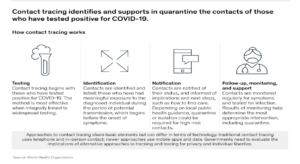Contact tracing is a tool that has been around for decades to help control the spread of infectious diseases. It has been used successfully in efforts to contain Ebola, SARS, MERS, tuberculosis, and other disease outbreaks. It is now a critical part of the fight against COVID-19. In practice, contact tracing begins with those who test positive for COVID-19. Those with whom they have had close contact are then identified, as they may have been infected too. These contacts are notified and supported through a period of quarantine—until they develop symptoms, pass the window of risk, or are proven not to have been exposed.
When a person tests positive for COVID-19, the laboratory or healthcare provider will provide a positive report to the Health Department. While many state and county departments of health will do contact tracing at the public level, the employer must do its own, and act quickly once they become aware that an employee who has recently been in the workplace has tested positive. Employers should determine who or what department will do the contact tracing internally, and then put into place strong training, processes and document management practices to be effective.
One way to quickly scale up capacity for case investigation and contact tracing is to specify two explicit job tasks for designated staff:[1]
Job Task 1. Case Investigation—Interviewing employees with COVID-19, eliciting their close contacts, monitoring the employees for COVID-19 symptoms, connecting employees to resources to support self-isolation
Job Task 2. Contact Tracing—Notifying close employee contacts of their potential exposure, referring them to testing, monitoring them for COVID-19 symptoms, and connecting contacts to resources to support self-quarantine[2]
Following are some best practices for employers and contact tracing:
- After an employee tests positive for COVID-19:
- Ensure the employee is sent home to prevent potential spread of the virus.
- Interview the infected employee by telephone, text, or video conference instead of in-person.
- Ask the infected employee to identify the work contacts with whom they have had close contact.[3]
- Consider interviewing supervisors, accessing security footage, schedules, access logs, lists of other employees, vendors, or clients who have been in close contact with the infected employee.
- Inform close contacts at work that they may have been exposed to COVID-19:
- Notify close contacts by telephone, text, or video conference instead of in-person of their exposure as soon as possible (within 24 hours of contact elicitation).
- Inform them of their status and next steps. Testing is recommended for all close contacts of employees who have tested positive for COVID-19.
- Send home all close contacts the employees worked with to ensure the infection does not spread.
- Provide resources to close contacts, i.e. symptoms to watch for, medical resources, EAP support, etc.
- Contact employees who have been put on leave daily to determine their well-being and assess whether any have developed symptoms.
- Those who test positive should remain quarantined until they test negative for the virus. Asymptomatic close contacts who test negative should be quarantined for 14 days.[4]
- Contact clients, vendors or other non-employees in the work environment who have had close contact with the infected employee.
- Keep your state and county health departments informed as they may want to be involved in any high-risk contacts. They also may have valuable input into the need for quarantine or other measures.
- CONFIDENTIALITY IS IMPERATIVE– Keep employee medical records separate from other employee files in a secure environment. Names of infected employees should not be reported to other individuals, HIPAA rules apply.
- Be sure to keep up-to-date and accurate records of contact tracing efforts. When necessary, they will be important in determining whether an OSHA incident report is required.
While navigating this new territory, be sure to utilize all of the resources available from associations, the CDC, and local public health organizations. And, don’t hesitate to reach out to ILG, we’re here for you!

COVID CONTACT TRACING SCAM ALERT: Postal Inspectors have become aware of reports that scammers are posing as Contact Tracers in an effort to trick citizens into providing personal information. For more information click here.
[1] To be effective, case investigation and contact tracing requires staff with adequate training, language skills, cultural sensitivity, supervision, and access to social and medical support for clients and their contacts.
[2] From CDC.gov – https://www.cdc.gov/coronavirus/2019-ncov/downloads/case-investigation-contact-tracing.pdf
[3] A close contact is someone “who was within 6 feet of an infected person for at least 15 minutes starting from 48 hours before illness onset until the time the patient is isolated,” according to the Centers for Disease Control and Prevention (CDC) trusted source guidelines on contact tracing.
[4] If testing is not available, close contacts should be treated as if they tested positive for the virus.

